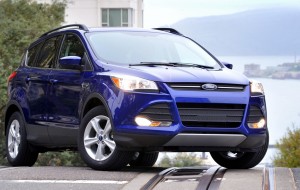
Ford says the 2013 Ford Escape is as useful as the original, but now in a sleek and stylish package.
For me, a new Ford Escape is personal. Our 2002 model was simply the best car we’ve ever owned.
With its optional V-6, it was powerful, it was as maneuverable as a go-kart and it had an interior that simply could not possibly have fit inside what looked like a smallish sport utility on the outside. Tough grey plastic cladding on the bottom gave that original Escape a rough and read, youthful look and it brushed off road debris without trouble.
There’s a good reason buyers have made it the best-selling small SUV on the market. It may have been a box, but it just worked.
But now Ford has built a new Escape, with swoopier styling, new powertrain options and a modern interior. The question is whether this new Escape can live up to or improve on one of the most useful vehicles of its size ever made.
Let’s take a look.
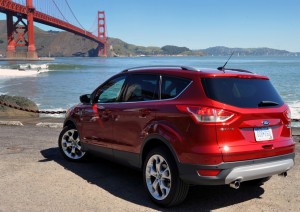
One of the most talked-about features of the new Escape is its hands-free liftgate, which is operated by waving a foot under the rear bumper. The SE tested here did not have the feature.
In a word no, it can’t. Despite receiving critical acclaim from many journalists, it won’t here.
Here’s the bottom line: This new Escape feels cramped, the transmission’s tuning is abrupt and while the styling is an obvious step ahead of the old, it’s derivative and looks like a lot of other cute utes on the market, particularly the Hyundai Tucson. On top of that, the fuel mileage isn’t all that great in real-world driving.
OK, let’s start with the good. The Escape is offered with three engines – all four-cylinders – a normally aspirated 2.5-liter and turbocharged 1.6-liter and 2.0-liter EcoBoosts.
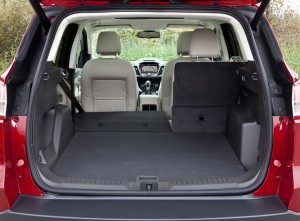
While the rear seat is cramped, the cargo area in the new Escape actually grows by nearly five cubic feet. It's also longer, so its more useful.
The test vehicle had the new 1.6, the Escape’s fuel economy leader. With 178 horsepower, this willing little engine made surprisingly quick work of passing situations on two-lane roads, eagerly revving past its 5,700-rpm power peak. And it’s a smooth little mill. The front-wheel drive test vehicle was rated at 26 city and 33 highway.
The base engine remains the 2.5, but now it makes 168 horses. It’s rated at 22/31. The 2.5 is available only with front-wheel drive.
The top engine is the turbocharged 2.0-liter, which is meant to replace the old V-6. With 240 horses, the 2.0 maintains the same 3,500-pound tow rating as the old V-6. My how times have changed. A FWD 2.0 is rated at 22/30. The 2.5 is rated to tow 1,500 pounds and the 1.6 can tow 2,000 pounds.
But we averaged just over 23 overall in a mix of rural two lanes and freeways. On a long-distance cruise consisting of about two-thirds freeway, we managed close to 26, although, admittedly, were driving in excess of the speed limit.
The major criticism is the interior. Ford brags that the Escape has more cargo space than the outgoing model. That has a lot to do with the overall proportions. The interior feels tight.
The new version is more than an inch wider, nearly four inches longer and rides on a wheelbase that is nearly three inches longer. Its height is also 1.6 inches lower.
Here’s a big surprise. In a day when many automakers are squeezing weight out of their new vehicles, the Escape actually adds 206 pounds, comparing this 1.6 to last year’s base four-cylinder with an automatic transmission (last year’s model offered a manual transmission with the base four cylinder, but the one doesn’t offer a manual). So the Escape went from a lightweight to a porker. Someone should be reprimanded over that fact. There’s just no excuse for a similar-sized vehicle with a smaller engine putting on so much weight.
Where the old Escape had an expansive center console where there were places to stash stuff, the new one’s center console is intrusive. If you want to stash your cellphone, your choices are a cupholder or maybe wedged next to the parking brake lever. The cloth front seats aren’t even comfortable, especially compared to the wide, comfy chairs in the old one.
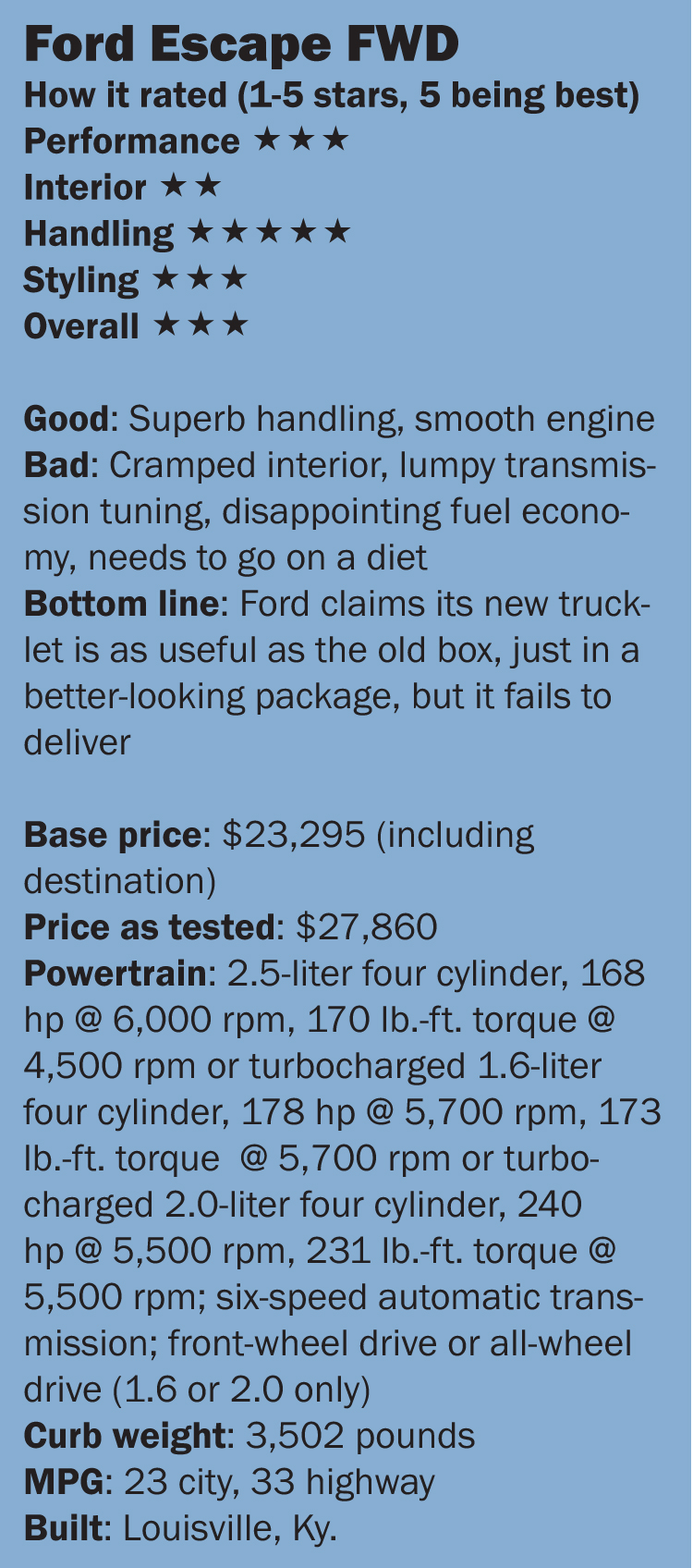 It gets worse in back. At 5-foot-10, I had to wedge myself into the back seat and then sit with my legs splayed apart. Ford says rear-seat legroom is down just 1.2 inches, but it feels like more.
It gets worse in back. At 5-foot-10, I had to wedge myself into the back seat and then sit with my legs splayed apart. Ford says rear-seat legroom is down just 1.2 inches, but it feels like more.
Cargo space is up nearly five cubic feet and it’s more useful. The original’s 29.4 cubic feet behind the second row was a rather vertical space, but the new one’s extra length means the space is more horizontal and thus more useful.
At least the ’13 Escape is a joy to drive. The ride is smooth and it attacks corners with a willingness that feels car-ish, not crossover-ish.
What isn’t a joy is the transmission tuning, which is lumpy. The transmission has a sport shift mode, but it doesn’t seem to change the character of transmission very much. It also has manual buttons on the shift lever.
The test vehicle, an SE, had a package including MyFordTouch with navigation and dual-zone climate control.
Unfortunately, it would seem that the only way to sync the temperature controls after adjusting the passenger side is to turn the system off and back on.
While rear-seat passengers don’t have much room, the seats are at least comfortable. And they flip down easily after pressing buttons to lower the headrests and another leaver to fold the 60/40 split seats.
Escape pricing starts $23,295. This SE opens at $25,895 (including destination). With the $1,570 MyFordTouch navigation and dual climate control and an equipment management system ($440) that includes roof rails with cross bars, tonneau cover and perimeter alarm, bringing the as-tested price to $27,860.
The bottom line is the Escape drives well and has better cargo space than its predecessor. But it’s passenger space – both for front- and back-seat passengers, is not as good, it’s transmission needs to be remapped and it needs to go on an immediate emergency diet.

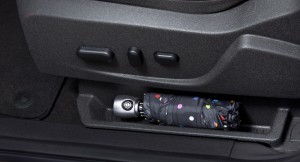
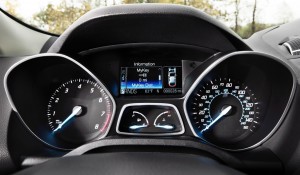
The horrid looking instrument pods and front end “gills” are appalling. What focus group liked these?
As far as adding 200 lbs., that isn’t good but it’s no surprise when going from an NA engine to a Turbo and the associated hardware required.
Most people know consumers buy autos/trucks based on looks not function or logic. Time will tell if the outrageous styling of the front end and instrument cluster turns out to be desirable or a cluster for sales.
The significantly smaller engine should offset the weight from the turbo hardware. That weight is probably in the structure, which I’m sure Ford felt it need to stiffen, as have other automakers.
I’d bet that focus groups had a huge hand in the styling of the new Escape because it looks so much like the others in the segment. I think it has a particularly Korean look to it. And to think we used to criticize Asian automakers for not advancing any new ground.
– Bryan Laviolette, TheDetroitBureau.com